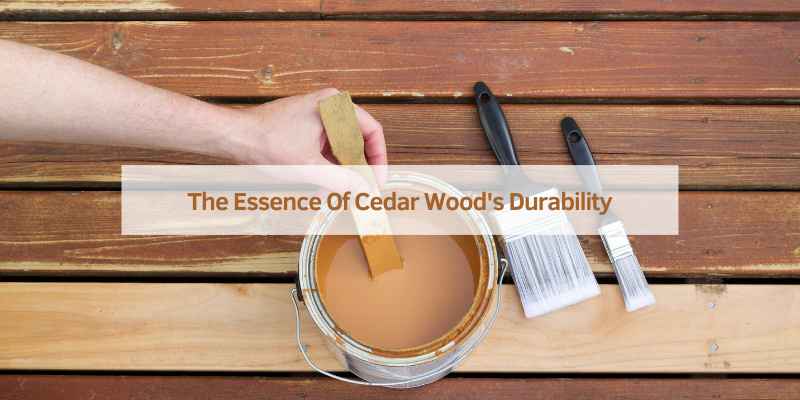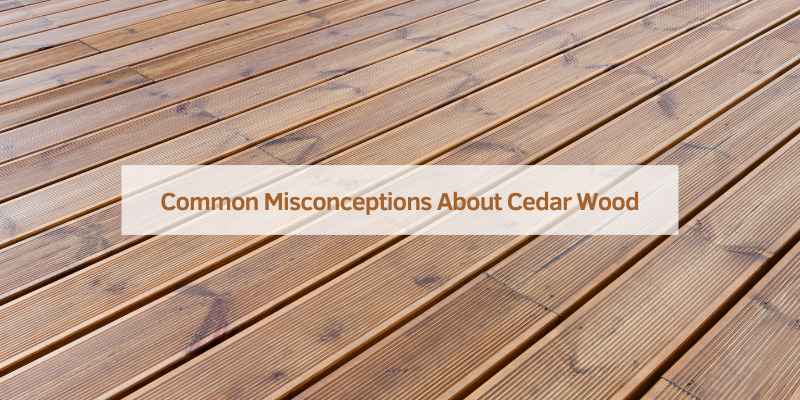Cedar wood can get wet, but water can cause it to crack and rot if left untreated. Cedar wood is naturally resistant to moisture, making it a popular choice for outdoor projects.
It contains natural oils and resins that protect it from decay caused by water and microorganisms. However, water can still penetrate cedar wood, leading to cracking and rotting over time if not properly treated with a water repellent preservative. To maintain the durability and longevity of cedar wood, it is essential to apply appropriate finishes that help enhance its natural water resistance properties.
By following proper maintenance and treatment methods, cedar wood can withstand exposure to moisture and remain in good condition for many years.
The Essence Of Cedar Wood’s Durability
Cedar wood contains natural preservatives that enhance its durability.
Cedar exhibits remarkable weather resistance properties, making it ideal for outdoor use.

When Cedar Encounters Water
When it comes to cedar wood, it’s natural to wonder how it holds up when exposed to water. Cedar is known for its remarkable weather resistance and durability, making it a popular choice for outdoor furniture, decking, and siding. However, it’s important to understand the immediate effects of moisture on cedar and the long-term implications of water exposure.
Immediate Effects Of Moisture On Cedar
When cedar encounters water, it undergoes certain changes that can affect its appearance and integrity. The immediate effects of moisture on cedar include:
- Checking cracks: Water entering the wood causes it to expand, resulting in tiny checking cracks. These cracks may start small, but over time, they can become more noticeable and lead to structural issues.
- Expansion and contraction: Cedar wood absorbs water, causing it to swell. As the moisture evaporates, the wood will shrink. This continuous process of expansion and contraction can weaken the wood over time.
While cedar is naturally resistant to moisture and decay, prolonged exposure to water can compromise its integrity and lead to long-term implications.
Long-term Implications Of Water Exposure
When cedar is exposed to water for extended periods, it can have the following long-term implications:
- Rot and decay: Despite its inherent resistance, cedar is not immune to rot and decay. Constant exposure to moisture can create a favorable environment for fungi and other microorganisms to thrive, leading to wood rot and decay.
- Cracking and warping: The continuous expansion and contraction of cedar due to water exposure can result in cracking, warping, and twisting. This can compromise the structural integrity of the wood and affect its overall aesthetic appeal.
- Reduced lifespan: While cedar is known for its longevity, prolonged water exposure can significantly reduce its lifespan. Without proper treatment and maintenance, cedar may not withstand the test of time and may require replacement sooner than expected.
It’s important to note that while cedar is naturally resistant to water, it still requires proper care and maintenance to ensure its longevity. Applying a waterproof finish or sealant can help protect cedar wood from excessive moisture and extend its lifespan.
In conclusion, while cedar is a durable and weather-resistant wood, it is not impervious to the effects of water exposure. Understanding the immediate effects and long-term implications of moisture on cedar is essential in maintaining its integrity and ensuring its longevity.
Cedar’s Battle With The Elements
Cedar wood contains natural preservatives, but when it gets wet, it can crack and rot over time. To protect it from water damage, it’s important to treat cedar with a waterproof finish or stain. However, with proper care and maintenance, cedar wood can last up to 20 years outdoors.
Sun And Cedar Interactions
Cedar wood can withstand sun exposure without significant damage due to its natural durability.
Rain And Cedar Interactions
While cedar is naturally resistant to water, prolonged exposure to rain can cause it to crack and deteriorate.
Handling Humidity And Heat In Saunas
Cedar’s ability to thrive in high humidity and heat makes it an ideal choice for sauna construction.
Outdoor Cedar Applications
Cedar wood is naturally resistant to moisture and decay, making it suitable for outdoor applications. However, if cedar wood gets wet, it can lead to cracking and rotting. Proper treatment and maintenance are essential to preserve the durability of cedar wood in wet conditions.
Cedar In Decking And Siding
Cedar wood is a popular choice for outdoor applications such as decking and siding due to its exceptional durability and resistance to moisture damage. Its natural oils and resins protect it from decay caused by fungi and other microorganisms, making it an ideal material for withstanding the elements.
Fencing And Furniture: Cedar’s Outdoors Roles
When it comes to outdoor fencing and furniture, cedar wood plays a crucial role in providing long-lasting and weather-resistant solutions. Its remarkable weather resistance makes it a preferred choice for creating sturdy and visually appealing fences and furniture that can withstand the rigors of outdoor environments.
Waterproofing Solutions For Cedar
If you have cedar wood in your outdoor space, you may be concerned about how it holds up against moisture. Cedar is a popular choice for outdoor furniture, decking, and siding due to its natural resistance to rot and decay. However, it’s important to take steps to ensure that your cedar wood remains protected from the elements.
Types Of Outdoor Cedar Finishes
When it comes to waterproofing cedar, there are several outdoor finishes that can provide protection against moisture. Here are some common types of outdoor cedar finishes:
- Oil-based Finishes: These finishes penetrate the wood to provide a protective barrier against water and UV rays.
- Sealants: Cedar sealants create a waterproof barrier on the surface of the wood, preventing water penetration.
- Clear Wood Preservatives: These preservatives contain fungicides and insecticides to protect cedar from decay and insect damage.
- Semi-transparent Stains: These stains add color to the wood while providing water resistance.
Best Practices For Sealing Cedar Wood
Properly sealing cedar wood is essential for maintaining its natural beauty and durability. Here are some best practices for sealing cedar wood:
- Clean the Surface: Before applying any finish, ensure that the cedar wood is clean and free of dirt, debris, and mildew.
- Apply Finish Evenly: Whether using a brush, roller, or sprayer, ensure that the finish is applied evenly to the cedar wood surface.
- Follow Manufacturer’s Instructions: Different finishes have specific application instructions, so it’s important to follow the recommendations provided by the manufacturer.
- Maintain Regular Maintenance: Periodically inspect the cedar wood for signs of wear and reapply finishes as needed to maintain water resistance.
Life Expectancy Of Cedar In The Open
Cedar wood can withstand exposure to the elements, but if it gets wet, it may develop cracks and rot over time. The natural preservatives in cedar provide some resistance, but waterproofing is essential to prolong its lifespan outdoors. Regular maintenance and sealing can help protect cedar from moisture damage.
Durability Of Untreated Vs Treated Cedar
Untreated cedar wood can last up to 15 years in the open, but it’s susceptible to decay and insect infestation. Treated cedar, on the other hand, can last up to 40 years or more, depending on the treatment method used.
One common treatment method is pressure treatment, which involves forcing preservative chemicals into the wood under high pressure. This helps the wood resist decay, insect infestation, and moisture damage. Another method is the application of a water-repellent finish, which helps to prevent water from penetrating the wood and causing damage.
Predicting Cedar’s Lifespan Outdoors
The lifespan of cedar wood in the open depends on various factors, such as the climate, exposure to elements, and the type of treatment used. In general, cedar wood can last up to 20-25 years in areas with a mild climate and low exposure to elements. In areas with harsher climates or high exposure to elements, the lifespan of cedar wood may be significantly shorter.
To predict the lifespan of cedar wood outdoors, it’s essential to consider the factors mentioned above. Additionally, regular maintenance, such as cleaning and reapplying a water-repellent finish, can help prolong the life of cedar wood in the open.
In conclusion, cedar wood can get wet, but with proper treatment and maintenance, it can withstand moisture damage and last for decades in the open. It’s essential to choose the right treatment method for your cedar wood and to regularly maintain it to ensure its longevity.
Cedar Maintenance And Care
Cedar wood is renowned for its natural resistance to moisture, decay, and insect damage. However, it is still essential to perform routine checks and maintenance to ensure its longevity and durability, especially when it comes to exposure to wet conditions. Proper care and timely repairs can significantly extend the lifespan of cedar structures.
Routine Checks For Cedar Structures
Regular inspections of cedar structures are crucial to identify any signs of water damage, decay, or structural issues. Here are some key areas to include in your routine checks:
- Inspect the surface for any visible cracks, warping, or discoloration.
- Check for signs of moisture accumulation, such as mold, mildew, or moss growth.
- Examine the joints and connections for any signs of weakness or deterioration.
- Assess the overall stability and structural integrity of the cedar components.
Repair And Restoration Tips For Wet Cedar
When wet conditions or water exposure impact cedar wood, prompt action is essential to prevent further damage and restore its condition. Here are some effective tips for repairing and restoring wet cedar:
- Drying: If the cedar wood becomes wet, ensure thorough drying to prevent moisture-related issues. Use fans or dehumidifiers to expedite the drying process.
- Sealing: Apply a high-quality wood sealant or finish to protect the cedar from future moisture exposure and enhance its weather resistance.
- Repairing Cracks: Address any visible cracks or checking by filling them with appropriate wood fillers or epoxy to restore the integrity of the wood.
- Preventative Treatments: Consider applying specialized treatments or coatings designed to enhance the cedar’s natural resistance to moisture and decay.
- Professional Assessment: For extensive damage or structural concerns, seek professional assistance to assess and address the issues effectively.
Common Misconceptions About Cedar Wood
When it comes to outdoor wood, cedar is often regarded as a top choice due to its natural resistance to moisture, decay, and insect damage. However, there are some misconceptions about cedar wood’s water resistance that need to be addressed. Let’s debunk these myths and gain a better understanding of cedar’s limitations.
Debunking Myths Of Cedar’s Water Resistance
One common misconception about cedar wood is that it is completely impervious to water. While cedar does possess natural oils and resins that provide some level of water resistance, it is not entirely waterproof. When exposed to prolonged and excessive moisture, cedar can still absorb water, leading to potential issues such as warping, splitting, and rotting.
Understanding Cedar’s Limitations
It’s important to recognize that cedar’s natural resistance to moisture has its limitations. While it can withstand moderate exposure to rain and humidity, prolonged contact with standing water or constant high levels of moisture can compromise its integrity. In such conditions, proper maintenance and periodic resealing or staining are essential to preserve cedar’s durability and aesthetic appeal.

Frequently Asked Questions
What Happens If Cedar Gets Wet?
When cedar gets wet, it can crack due to water absorption, leading to tiny checking cracks. Outdoor cedar may rot and crack from water damage if not treated promptly.
Can Cedar Withstand Rain?
Yes, cedar wood can withstand rain. Cedar is known for its natural resistance to moisture, making it a suitable choice for outdoor furniture, structures, and saunas. However, it is important to note that if water soaks into cedar wood, it may cause cracking and damage over time.
To protect cedar from water damage, it is recommended to treat it with water repellent preservatives or finishings.
How Long Does Cedar Wood Last Outside?
Cedar wood can last outside for up to 20 years, but it may crack and rot from water damage if not properly treated.
How To Waterproof Cedar Wood?
To waterproof cedar wood, follow these steps:
1. Clean the wood surface thoroughly.
2. Sand any rough areas.
3. Apply a waterproofing sealer or stain specifically designed for cedar wood.
4. Use a brush or roller to evenly coat the wood.
5. Allow the sealer to dry completely before exposing the wood to moisture. Remember, proper maintenance and reapplication of the waterproofing product is essential to keep the cedar wood protected.
Conclusion
Cedar wood can get wet, but it is naturally resistant to moisture and decay. However, prolonged exposure to water can cause cracks and damage to the wood. To protect cedar wood from water damage, it is recommended to use water-resistant treatments and finishes.
With proper care and maintenance, cedar wood can last for up to 20 years or more. Choose cedar wood for your outdoor projects and enjoy its remarkable weather resistance properties.


